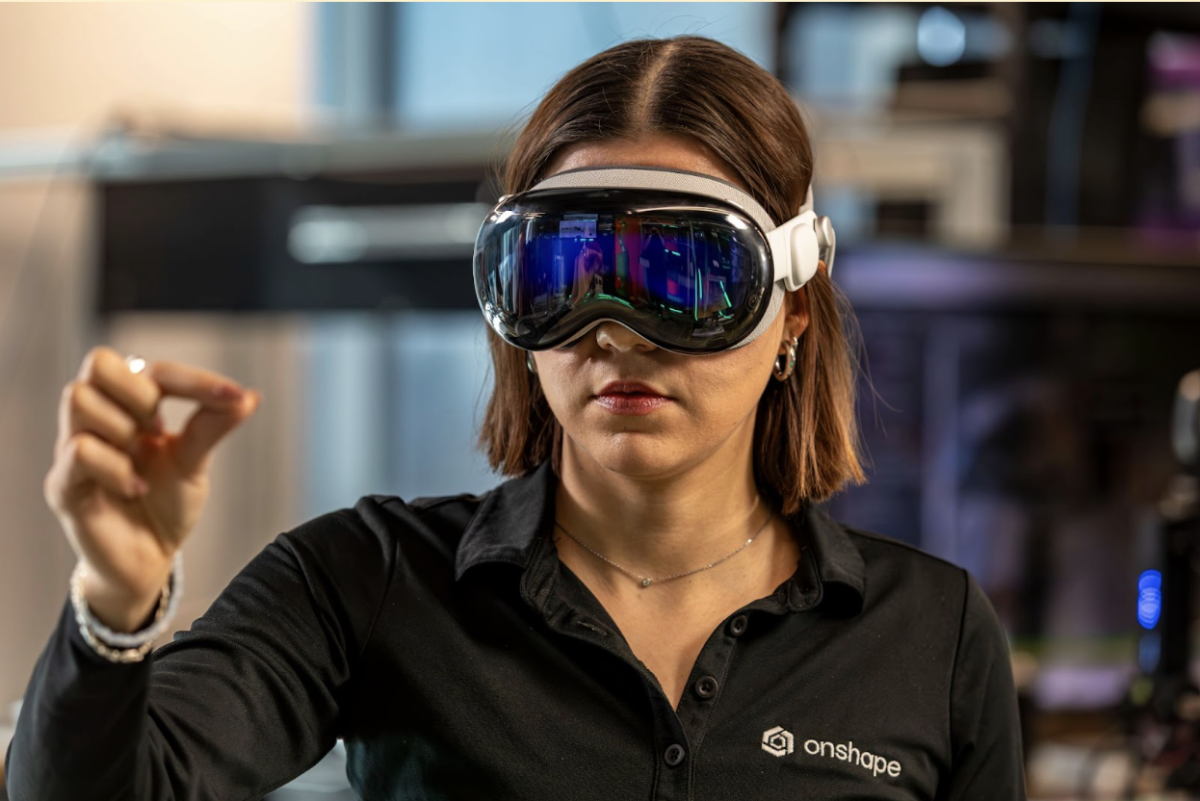On February 2, 2024, Apple released their new product: the Vision Pro, a device that encompasses the advancements of virtual reality (VR) and artificial intelligence (AI). It allows the user to immerse themselves in a virtual world, from emulating a desk space to a scenic simulation that wraps around you.
The world has seen many recent advancements with AI, such as OpenAI’s ChatGPT and Microsoft’s BingAI, but the development of VR has not been in the limelight for a while. The Vision Pro is a large breakthrough in technology and raises many opportunities and challenges for using VR as a tool in different fields.
“Featuring vision OS, the world’s first spatial operating system, Vision Pro lets users interact with digital content in a way that feels like it is physically present in their space,” said Apple, in their online newsroom.
Goal and Vision
Apple’s goal with the Vision Pro included bringing a new VR experience to the user and enhancing entertainment with spatial surrounding and interaction, while still allowing the user to connect to the world around them:
“Vision Pro seamlessly blends digital content with the physical world, unlocking powerful spatial experiences in an infinite canvas,” Apple said, explaining that the device “acts as a lens” for cameras and sensors, which integrate the digital experience with the physical world.
Apple released a short film detailing the different aspects of the Vision Pro from the perspective of a user, which allowed potential users to experience how the device works and functions to enhance their experience. The film also demonstrated how the Vision Pro works interconnectedly with other Apple devices for greater accessibility.
“Experiences on Vision Pro can also expand on three dimensions, filling the entirety of your space…[it] brings the scale and wonder of a movie theater to whatever space you’re in,” the film said. The versatility of the Vision Pro provides more diverse opportunities for entertainment, allowing users to resize the screen and scale the immersivity of the experience to personal preference.
Dr. Yuhang Zhao, an Assistant Professor in Computer Science at the University of Wisconsin-Madison, explained the potential that the Apple Vision Pro had to impact society and the development of VR.
“I do believe that Apple Vision Pro presents a new vision into the future of personal devices, where people can expand their workspace in the 3D space without being limited by the physical computer screens…and get a more realistic face-to-face but remote collaboration experience,” Dr. Zhao said.
The incorporation of cameras and sensors into the device to blend digital and physical worlds can remove the aspect of technology that disconnects one from the outer world, creating a parallel between the two mental states. There is also a physicality to the apps that creates a sense of reality when using the Vision Pro.
“Beyond AR/VR, I think it is a new exploration into what personal devices could be to support information access, sharing, and collaboration,” Dr. Zhao said.
Release and Impact
The Apple Vision Pro, despite its complex development, elicited a mixed reaction from experts and the general public. Wearing the device for an extended period has unknown effects on the user and their brain, causing experts to recommend caution when using the Vision Pro for long periods of time.
The pass-through technology used in the Vision Pro has potentially detrimental effects on the user, including restricting visual perception and changing behavioral and motor function. This results from adjusting from normal human eyesight to the delayed, distorted vision of the Vision Pro.
Basic motor tasks are much harder because of the decreased coordination between mind and body when adjusting to the Vision Pro, which may also pose a safety concern for the user if a normal safety precaution is not taken.
Vision could also potentially be impaired while wearing the Vision Pro, due to the battery dying in the middle of an activity. For example, if a user’s Vision Pro dies while they are riding a bicycle, the consequences could be fatal.
Although the Apple Vision Pro isn’t fully virtual reality, studies have shown that VR can affect memory and the ability to distinguish between the virtual world and reality. This only adds to the social isolation that a VR user commonly experiences when wearing a VR or mixed-reality headset.
In addition to the mental effects of the Vision Pro, the cost of the device has caused potential users to reconsider their decision to buy it. When we asked Dr. Zhao about her opinion on the Vision Pro’s cost, she explained that the high price could offset a buyer’s interest in the headset.
“Most people won’t be willing to spend $3500 to purchase this device for the spatial computing experience,” Dr. Zhao said. “It also has accessibility issues…[however] it does integrate all accessibility support from iPhone to Vision Pro.”
Future of Virtual Reality
The concept of VR has been around for decades, but the breakthrough of the Apple Vision Pro is crucial to the continued future development of this technology and system. Apple utilized sensors and cameras to capture movement and provide immersiveness for the user, a component which is being increasingly integrated into society.
“I think the VR models will continue to grow and evolve as needed,” said Lori Hunt, a computer science teacher at Middleton High School (MHS). “When I was taking a class on this type of technology at MIT a few years ago, we were watching the government use robots and VR for training soldiers in unsafe environments, which can potentially save lives.”
VR is already partially being used in education for more interactive learning, healthcare for various treatments and entertainment regarding games and movies. The development of more advanced VR could lead to developments such as surgery training, virtual workplaces and immersive movies.
“For XR (extended reality), Apple Vision Pro is a big step towards improving video passthrough experience, and more easy-to-use interactions…and demonstrates the potential of using head-worn XR devices in daily life,” Dr. Zhao said.
The Apple Vision Pro is also a great example of how AI can be used for possible future applications. The device is able to reconstruct and render a stereo vision experience, use hand gesture recognitions for interaction, and generate photorealistic avatars in facetime. This gives insight on the possible uses for AI in the future.
The two systems, VR and AI, have not previously been incorporated into a single product, which is another reason that the Apple Vision Pro is a milestone for the development of both.
However, it still has the potential to be harmful to society, and not all of the Apple Vision Pro nor the future developments of AI and VR will be positive for our society.
“One potential worry is that as people start using VR for personal reasons,” Hunt said. “They might grow further and further from developing healthy, [in real life] relationships, which could be really damaging.”
Integration into Lifestyles
With the release of OpenAI’s chatGPT, the AI platform has already been seamlessly incorporated into numerous organizations and lifestyles, helping to interact with customers and providing answers and support for various other topics.
The Apple Vision Pro’s release could provide for similar changes in work styles and organization, including the projection of apps anywhere to make working in different places more accessible and easier.
“With reduced weight and price and enhanced accessibility…[Vision Pro] may fundamentally change people’s life and work style,” Dr. Zhao said.
The barriers in the early models of Apple Vision Pro may be difficult to work with now, but as later Vision Pro models work to deal with these problems, it could drastically enhance entertainment, and more importantly work, for many people.
“I can see usefulness in entertainment, but I don’t think it’s really essential and it will likely lose its novelty after a short while,” Hunt speculated. “However, I think that the high-end Virtual Reality is really helpful in things like training pilots, and people who are involved in safety [fields]. It can give a full experience without the danger.”
The possibilities for VR utilization in different fields are pivotal as society transforms into a more developed and high-tech world. It could improve various aspects of jobs and sectors of society, like healthcare and education. For example, surgeons are able to use the Apple Vision Pro to access surgical plan details anytime and anywhere through an app called myMako, allowing them a more efficient and intuitive way to gain information.
“Beyond changing the lifestyle of general users, I also see its potential for people with disabilities…by providing additional assistance to them via AI-powered task interpretation and suitable feedback,” said Dr. Zhao, whose research area revolves around using AR/VR and AI-powered systems to enhance human abilities.
Apple Vision Pro has developed an early version of this through another one of its apps called Xaia, which “offers patients AI-enabled, conversational mental health support in relaxing spatial environments where they can also do deep breathing exercises and mediation.”
The Vision Pro has the potential to change our society with astounding capabilities for improvements in healthcare and education, and the combination of two incredible systems, VR/AR and AI, into singular, impactful devices.









